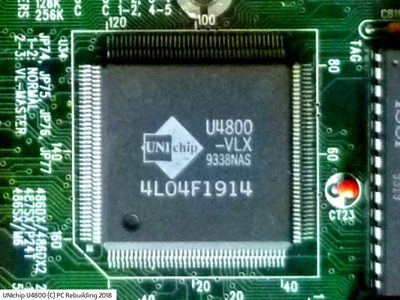Reply 41 of 46, by WJG6260
- Rank
- Member
A really, really quick check and this looks like the OPTi499, based on the schematic on Page 3 of the 499 databook. Not sure, but this is what my gut says, as voltage and ground seem to line up...
EDIT: Okay, so Vdd and Vss are in the same place, but there's lots of differences in where the address lines are. I can't really read the USA chipset pinout too well, but it seems that there's enough differences to say that it's not really a clone of the 499. But the locations of Vdd and Vss being mostly similar seems interesting. The 495XLC has too few pins, so that's out. Are there any other OPTi 386/486 hybrid chipsets worth checking against?
Reply 42 of 46, by Eep386
Looking closer, the UniChip U4800 chipset has 160 pins while the mysterious US Integration SC chipset has 208 according to the manual linked.
The OPTi 82C499 has the same number of pins, but the pinout is quite different so I don't think it's that, either.
I've looked through dozens of other chip datasheets but still can't quite get a match.
It's possible it is its own thing entirely 😖
Life isn't long enough to re-enable every hidden option in every BIOS on every board... 🙁
Reply 43 of 46, by Deksor
- Rank
- l33t
Are you sure we're talking about the same unichip ? I'm talking about the one installed on this board : https://www.ultimateretro.net/en/motherboards/4357 which does have 208 pins
As for the matching VCC/GND pins, there might be an explanation for this.
We've discovered that the "SARC" chipset used on some pcchips 386SX boards are just a big GAL chip made by toshiba. Why does this matter ? Well all of these chips (Unichip, Opti and USA) are also made by toshiba. This may be a stretch, but maybe these chips are also using some sort of PAL and they all use the same one, but it's programmed differently ?
Trying to identify old hardware ? Visit The retro web - Project's thread The Retro Web project - a stason.org/TH99 alternative
Reply 44 of 46, by Eep386
The OPTi 82C499 is definitely *not* a candidate, despite having the same number of pins, the pinout just doesn't match up as a whole.
I honestly don't know why they would make two different package U4800 chipsets. It's not by any means implausible, just weird.
Most Unichips I've met have 160 pins like so:
However, for whatever reason that particular Unichip on the board (that picture on the board you shared, is from my own GMB-386UN), uses 208 pins. I guess UniChip just wanted to confuse the heck out people. The VLX edition seems to have come a bit later so maybe the VLX is a cost reduction?
But maybe there's a way to settle this. Try taking the BIOS off the board and plugging it into a known good Unichip powered 486 board, and see if it POSTs? That was how I was able to determine the identity of a Morse-relabeled OPTi chipset.
Life isn't long enough to re-enable every hidden option in every BIOS on every board... 🙁
Reply 45 of 46, by Eep386
Deksor wrote on 2022-03-19, 21:10:This may be a stretch, but maybe these chips are also using some sort of PAL and they all use the same one, but it's programmed differently ?
Again, while not implausible, I think it more likely that Toshiba simply likes to fab chips in a very particular (and peculiar) manner. Though, the 160-pin package U4800 chips also seem to be fabbed by Toshiba too, as do OPTi's chips.
It's a shame the pinouts were never really standardized, in any case.
Life isn't long enough to re-enable every hidden option in every BIOS on every board... 🙁
Reply 46 of 46, by Beerfloat
Hey, I recently acquired one of these MASTER REV A-3 boards of my own, and though I have yet to try powering it on, I noticed that on my board the 386 and 387 pads are not populated with sockets. The capacitors in that area are also missing. I was wondering if you might be able to read the values written on any of the tantalum caps at positions C68, C69, C70, C71, C72, C73 and/or C74?
Unfortunately I can’t make out the values from any of the pictures of this board and its close relatives that I can find online. I’d like to try soldering on the missing sockets and run some 386 and FPU versions on this board, as well as 486s (mine came with a 486SX). And maybe help debug some issues others like yourself are experiencing.
Thanks in advance!
